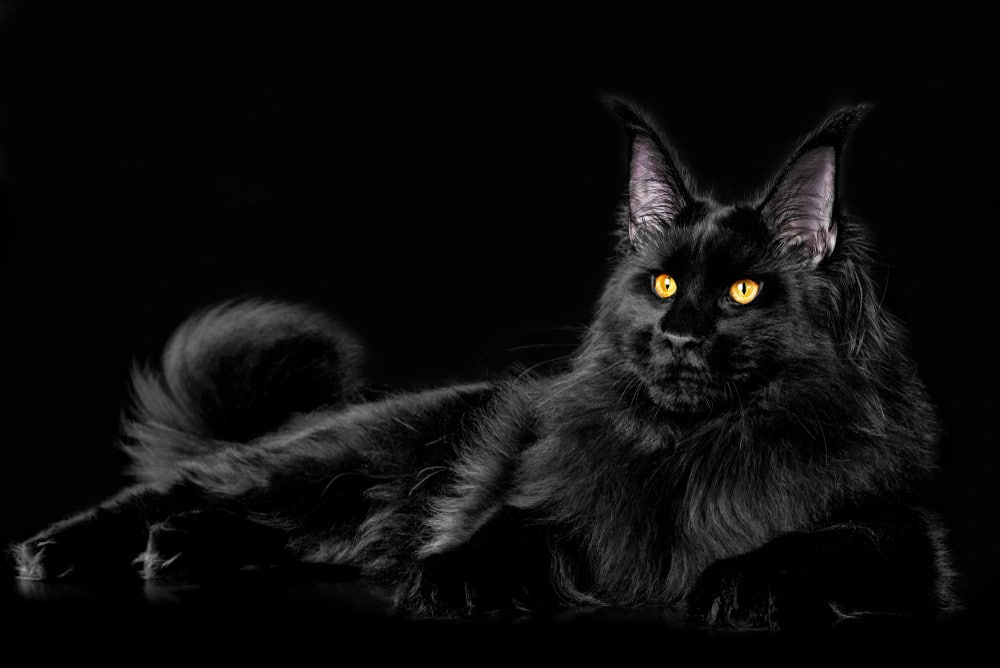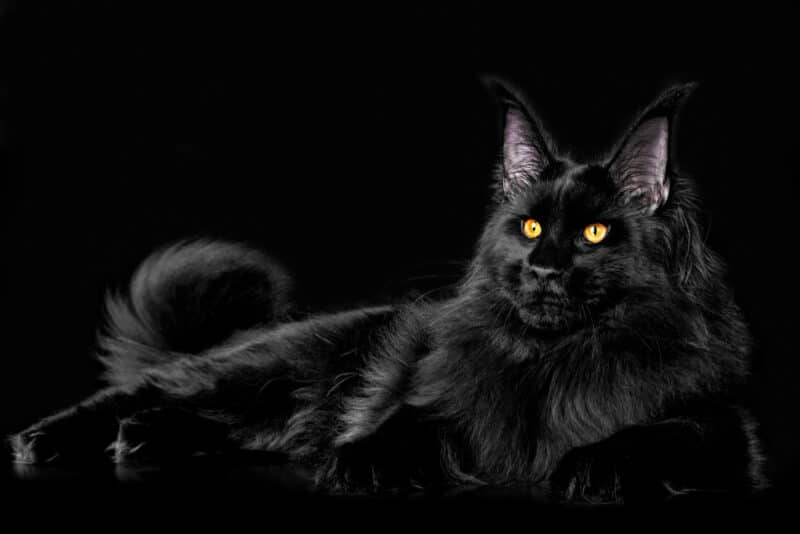Click to Skip Ahead
Maine Coons are one of the most favored cat breeds in the world for good reason. They’re super sweet, intelligent, and quite adaptable. They get along great with just about everyone—kids, other cats, and dogs included.
If you’re considering welcoming a big, fluffy cat into your household, the Maine Coon might be just what you’re searching for. Today we’re going to take a look at the black Maine Coon in particular, so read on to learn everything you need to know about this breed’s history, origin, and personality.
Breed Overview
Height:
10 – 16 inches
Weight:
12 – 20+ pounds
Lifespan:
10 – 15 years
Colors:
Black
Suitable for:
Families with children, families with other pets
Temperament:
Affectionate, gentle, friendly, intelligent
Black Maine Coons aren’t a separate type of Maine Coon, but instead one of the few colors that these cats are available in. While they share the same personality traits as other Maine Coons, the black kind are visually stunning with their coal-colored coats, tufted ears, and fluffy tails.
Black Maine Coon Breed Characteristics
The Earliest Records of Black Maine Coons in History
Since black Maine Coons are not a separate breed, let’s look closer at the history of Maine Coons in general.
Maine Coons originated in Maine, the easternmost state in the New England region of Northeastern America, and are considered one of the original native cat breeds of the United States. Most experts believe that the breed came to be after mating between short-haired domestic cats and long-haired breeds from overseas took place.
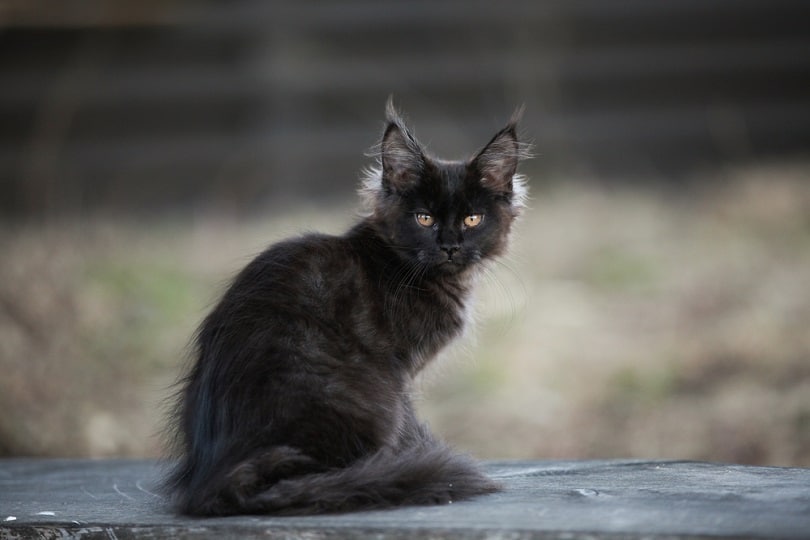
How The Black Maine Coon Gained Popularity
Maine Coons became popular in the late 1800s when they first began being entered into contests and shows in Maine and Boston. A female Maine Coon named Cosey was entered into the first North American cat show in New York City in 1895 and won the silver collar. Cosey was also named Best in Show.
During the early years of the 20th century, other long-haired cat breeds, like Persians, were introduced to America, causing the Maine Coon’s popularity started to decline. It declined so much that there was a 40-year span in which a Maine Coon didn’t win a single national cat show, a far cry from what had happened the century prior. This decline hurt the breed so much that in the 1950s, it was believed that Maine Coons were extinct. Thankfully, it was later determined that this declaration was an exaggeration, though there was no denying how few Maine Coons were left.
At this point, a group of Maine Coon fanciers created the Central Maine Cat Club (CMCC) and worked tirelessly to revive them. For over a decade, the CMCC hosted cat shows and held exhibitions to increase interest in Maine Coons and is even credited for writing the first breed standard.
Formal Recognition of The Black Maine Coon
Thanks to the dedication and perseverance of the CMCC and other Maine Coon breeders, the black Maine Coon was accepted by the Cat Fanciers’ Association championship status in 1976.
In 1979, The International Cat Association (TICA) was founded by a handful of cat enthusiasts and is now considered the world’s largest genetic cat registry. TICA accepted black Maine Coons for championship right away.
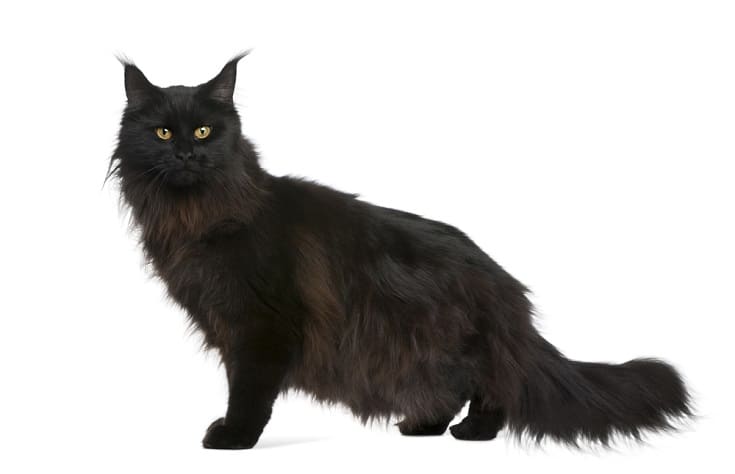
Top 3 Unique Facts About The Black Maine Coon
1. Maine Coons almost went extinct.
These gentle giants were popular during cat shows in the 19th century, but their existence was threatened in the early 20th century when long-haired cats were brought over from overseas. Thankfully, the Maine Coon has since recovered, consistently earning a spot on The Cat Fanciers’ Association’s top ten cat breed list.
2. Many Myths Surround The Breed.
The Maine Coon’s origin is shrouded in mystery and myths. One such legend claims that the breed was created by crossing a domestic cat with a different species, like a raccoon or a bobcat. Another states that the Maine Coon is a descendant of the cats that traveled on Viking ships. A third myth says that before Marie Antoinette was executed in the late 1700s, she tried to leave France with several of her favored possessions, including her cats, who were either Turkish Angora or Siberians. Though Marie didn’t get to America, her cats docked in Maine, where they mated with short-haired breeds and developed Maine Coons.
3. Black Maine Coons must be all black.
The Maine Coon’s breed standard, according to the Cat Fanciers’ Association, requires the cat in question to be a dense coal black from roots to the tip of the fur. They cannot have any tinge of rusting on their fur tips or smoke undercoat. Their paw pads need to be black or brown.
TICA standards are similar in that only dominant black-based colors are permissible. Non-dominant black-based colors like lilac, chocolate, or cinnamon are not allowed.
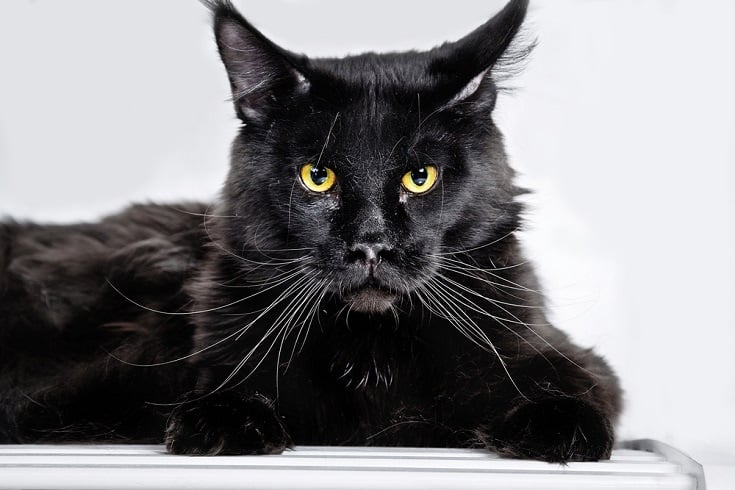
Does The Black Maine Coon Make a Good Pet?
Black Maine Coons, like all Maine Coons, make fantastic pets. These gentle giants are not only a sight to see, with their sturdy frame, gorgeous coal-like coats, and rugged appearance, but they have an affectionate nature and playful energy, too. Maine Coons enjoy being around their humans and are great companions. They’re known for their quiet chirping sounds and relaxed and laid-back attitudes.
Conclusion
Black Maine Coons are truly beautiful cats with a unique and enthralling history and plenty of redeemable qualities. They make great pets and, despite almost going extinct, are a highly sought-after breed. Now that you know more about their history and origins, you can make an informed decision about whether the black Maine Coon is the right pick for you and your family.
Featured Image Credit: Seregraff, Shutterstock

